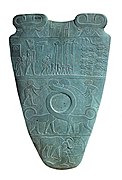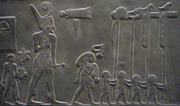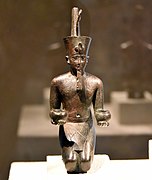Deshret
| Deshret | |
|---|---|
 Deshret, the Red Crown of Lower Egypt | |
| Details | |
| Country | AncientLower Egypt |
| Successors | Pschent |
| Deshret, Red Crown (crown as determinative) inhieroglyphs | ||||
|---|---|---|---|---|
Deshret(Ancient Egyptian:𓂧𓈙𓂋𓏏𓋔,romanized:dašrat,lit. 'Red One') was the Red Crown ofLower Egypt.When combined with theHedjet(White Crown) ofUpper Egypt,it forms thePschent(Double Crown), in ancient Egyptian called thesekhemti.
The Red Crown inEgyptian languagehieroglyphseventually was used as the vertical letter "n". The original "n" hieroglyph from thePredynastic Periodand theOld Kingdomwas thesigndepicting ripples of water.
The wordDeshretalso referred to the desert Red Land on either side ofKemet(Black Land), the fertile Nile river basin.
Significance[edit]
In mythology, the earth deityGeb,original ruler of Egypt, investedHoruswith the rule overLower Egypt.[1]The Egyptianpharaohs,who saw themselves as successors of Horus, wore thedeshretto symbolize their authority over Lower Egypt.[2]Other deities wore thedeshrettoo, or were identified with it, such as the protective serpent goddessWadjetand the creator-goddess of Sais,Neith,who often is shown wearing the Red Crown.[3]
The Red Crown would later be combined with theWhite CrownofUpper Egyptto form theDouble Crown,symbolizing the rule over the whole country, "The Two Lands" as the Egyptians expressed it.[4]
Records[edit]
No Red Crown has been found. Several ancient representations indicate it was woven like a basket from plant fiber such as grass, straw, flax, palm leaf, or reed.
The Red Crown frequently is mentioned in texts and depicted in reliefs and statues. An early example is the depiction of the victorious pharaoh wearing thedeshreton theNarmer Palette.A label from the reign ofDjerrecords a royal visit to the shrine of the Deshret which may have been located at Buto in the Nile delta.[5]
The fact that no crown has ever been found buried with any of the pharaohs, even in relatively intact tombs, might suggest that it was passed from one reign to the next, much as in present-day monarchies.
Toby Wilkinson has cited the iconography on rock art in the Eastern Desert region as depicting what he interpreted to be among the earliest representations of the royal crowns and suggested the Red Crown could have originated in the southern Nile Valley.[6]
Phonogram[edit]
| 1 Red Crown, Deshret 2 also, vertical "N" inhieroglyphs | ||
|---|---|---|
Deshret, theancient EgyptianRed Crown, is one of the oldestEgyptian hieroglyphs.As aniconographicelement, it is used on the famouspaletteof PharaohNarmeras the"Red Crown of the Delta",the Delta beingLower Egypt.
The first usage of the Red Crown was in iconography as the symbol forLower Egyptwith theNile Delta,horizontal letter 'n',Gardinerno. 35,
Later it came to be used in the Egyptian language as anAlpha beticuniliteral,vertical form for letter "n" as aphonemeorpreposition.It became functional in running hieroglyphic texts, where either the horizontal or vertical form preposition satisfied space requirements.
Both the vertical and horizontal forms are prepositional equivalents, with the horizontal letter n, theN-water ripple (n hieroglyph)being more common, as well as more common to form parts ofEgyptian languagewords requiring thephoneme'n'.
One old use of the red crown hieroglyph is to make the word: 'in'!, (formerlyan-(a-with dot)-(the "vertical feather" hieroglyph a, plus the red crown). Egyptian "in" is used at the beginning of a text and translates as:Behold!,orLo!,and is an emphatic.
The Red Crown is also used as adeterminative,most notably in the word for deshret. It is also used in other words or names of gods.
- Use in the Rosetta Stone

In the 198 BCRosetta Stone,the'Red Crown'as hieroglyph has the usage mostly of the vertical form of thepreposition"n". In running text, word endings are not always at the end ofhieroglyph blocks;when they are at the end, a simple transition to start the next block is a vertical separator, in this case the preposition, vertical n, (thus a space saver).
Since the start of the next hieroglyphic block could also be started with a horizontal "n" at the bottom of the previous block, it should be thought that the vertical "n" is also chosen for a visual effect; in other words, it visually spreads out the running text of words, instead of piling horizontal prepositions in a more tight text. Visually it is also a hieroglyph that takes up more 'space'-(versus a straight-line type for the horizontalwater ripple); so it may have a dual purpose of a less compact text, and a bettersegue-transition to the next words.
The Red Crown hieroglyph is used 35 times in the Rosetta Stone; only 4 times is it used as a non-preposition. It averages once per line usage in the 36 lineDecree of Memphis (Ptolemy V)-(Rosetta Stone).
See also[edit]
- Atef–HedjetCrown with feathers identified withOsiris
- Khepresh– Blue or War Crown also called Royal Crown
Gallery[edit]
-
Ramesside Periodostracon,pharaoh wearing Red Crown
-
Narmer Palette,front
-
Close-up ofNarmer Palette,Pharaoh Narmer with crown
-
Bronze statuette of a Kushite king wearing the red crown of Lower Egypt; 25th Dynasty, c. 670 BCE, Neues Museum, Berlin
-
A guardian statue wearing the red crown which reflected the facial features of the reigning king, probably Amenemhat II or Senwosret II, and which functioned as a divine guardian for theimiut;made of cedar wood and plasterc.1919–1885 BC
-
Philistine captives at Medinet Habu
-
Stele of Tchia at the Louvre
-
Apepbeing slain
References[edit]
- ^Ewa Wasilewska,Creation Stories of the Middle East,Jessica Kingsley Publishers 2000, p.128
- ^Toby A. H. Wilkinson,Early Dynastic Egypt,Routledge 1999, p.194
- ^George Hart,The Routledge Dictionary Of Egyptian Gods And Goddesses,p.100
- ^Ana Ruiz,The Spirit of Ancient Egypt,Algora Publishing 2001, p.8
- ^Toby A. H. Wilkinson,Early Dynastic Egypt,Routledge 1999, p.284
- ^Wilkinson, Toby (2003).Genesis of the Pharaohs: dramatic new discoveries rewrite the origins of ancient Egypt.London: Thames & Hudson. pp. 54–82.ISBN0500051224.
- ^"Guardian Figure".metmuseum.org.Metropolitan Museum of Art.Retrieved9 February2022.
- Budge.An Egyptian Hieroglyphic Dictionary,E.A.Wallace Budge,(Dover Publications), c 1978, (c 1920), Dover edition, 1978. (In two volumes) (softcover,ISBN0-486-23615-3)
- Budge.The Rosetta Stone,E.A.Wallace Budge,(Dover Publications), c 1929, Dover edition(unabridged), 1989. (softcover,ISBN0-486-26163-8)











